eng MAZDA MODEL CX-9 2018 (in English) Manual PDF
[x] Cancel search | Manufacturer: MAZDA, Model Year: 2018, Model line: MODEL CX-9, Model: MAZDA MODEL CX-9 2018Pages: 640
Page 137 of 640

5. After 20 seconds, the system is fullyarmed.
NOTE
•The theft-deterrent system can also be
armed by activating the auto relock
function with all the doors, the liftgate
and the hood closed.
Refer to Transmitter on page 3-4.
•The system will disarm if one of the
following operations takes place within
20 seconds after pressing the lock
button:
•Unlocking any door.
•Opening any door.
•Opening the hood.
•Switching the ignition ON.
To rearm the system, do the arming
procedure again.
•When the doors are locked by pressing
the lock button on the transmitter or
using the auxiliary key while the
theft-deterrent system is armed, the
hazard warning lights will flash once to
indicate that the system is armed.
▼ To Turn Off an Armed System
An armed system can be turned off using
any one of the following methods:
•Pressing the unlock button on the
transmitter.
•Starting the engine with the push button
start.
•(With the advanced keyless function)
•Pressing a reque
st switch on the
doors.
The hazard warning lights will flash twice.
NOTE
When the doors are unlocked by pressing
the unlock button on the transmitter while
the theft-deterrent system is turned off, the
hazard warning lights will flash twice to
indicate that the system is turned off.
▼ To S t o p t h e A l a r m
A triggered alarm can be turned off using
any one of the following methods:
•Pressing the unlock button on the
transmitter.
•Starting the engine with the push button
start.
•(With the advanced keyless function)
•Pressing a request switch on the
doors.
•Pressing the electric liftgate opener
while the key is being carried.
•Pressing the power liftgate button on
the transmitter.
The hazard warning lights will flash twice.
Before Driving
Security System
3-47
CX-9_8GC3-EA-17G_Edition1 2017-5-29 10:13:38
Page 138 of 640
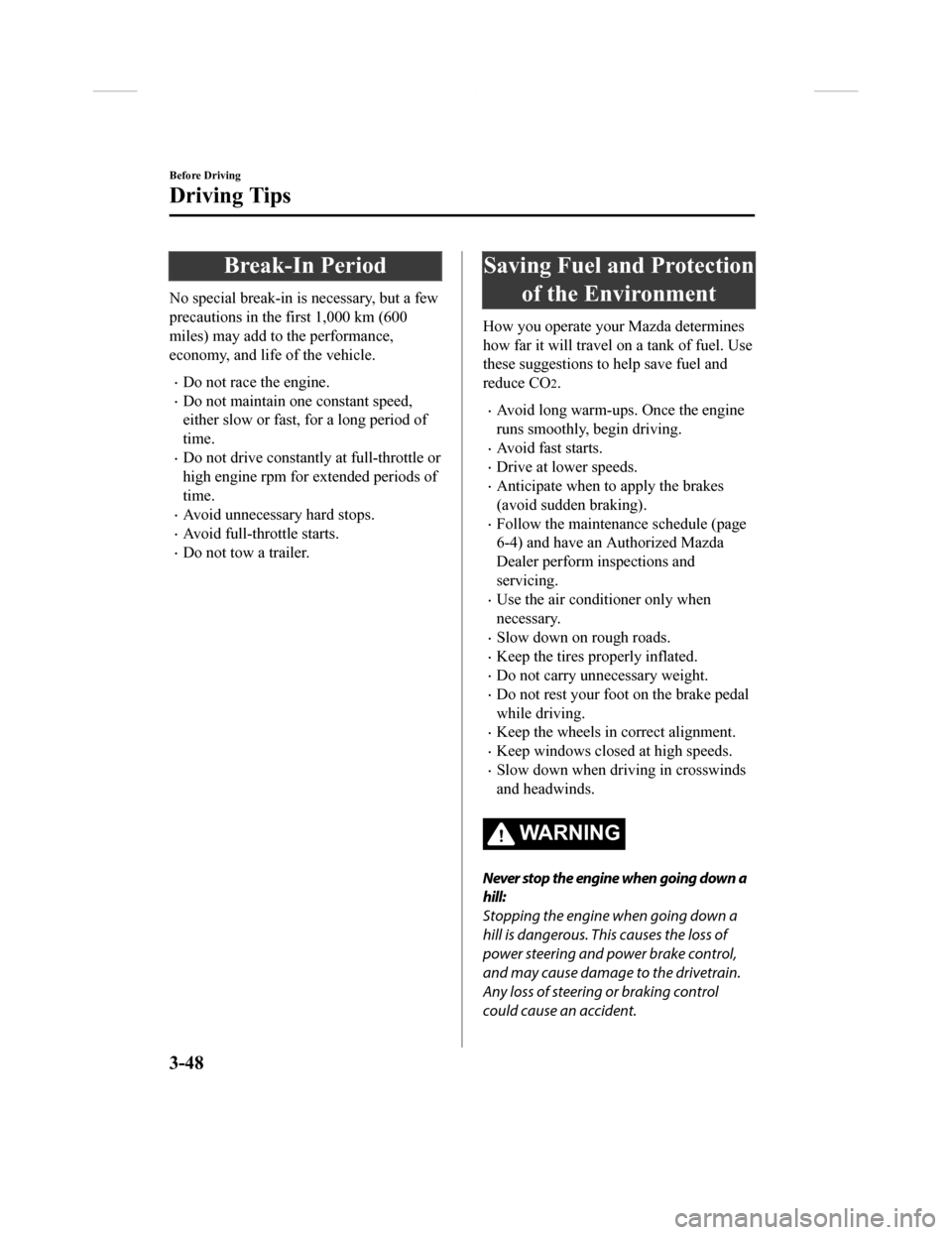
Break-In Period
No special break-in is necessary, but a few
precautions in the first 1,000 km (600
miles) may add to the performance,
economy, and life of the vehicle.
•Do not race the engine.
•Do not maintain one constant speed,
either slow or fast, for a long period of
time.
•Do not drive constantly at full-throttle or
high engine rpm for e xtended periods of
time.
•Avoid unnecessary hard stops.
•Avoid full-throttle starts.
•Do not tow a trailer.
Saving Fuel and Protection of the Environment
How you operate your Mazda determines
how far it will travel on a tank of fuel. Use
these suggestions to help save fuel and
reduce CO
2.
•Avoid long warm-ups. Once the engine
runs smoothly, begin driving.
•Avoid fast starts.
•Drive at lower speeds.
•Anticipate when to apply the brakes
(avoid sudden braking).
•Follow the maintenance schedule (page
6-4) and have an Authorized Mazda
Dealer perform inspections and
servicing.
•Use the air conditioner only when
necessary.
•Slow down on rough roads.
•Keep the tires properly inflated.
•Do not carry unnecessary weight.
•Do not rest your foot on the brake pedal
while driving.
•Keep the wheels in correct alignment.
•Keep windows closed at high speeds.
•Slow down when driving in crosswinds
and headwinds.
WA R N I N G
Never stop the engine when going down a
hill:
Stopping the engine when going down a
hill is dangerous. This causes the loss of
power steering and power brake control,
and may cause damage to the drivetrain.
Any loss of steering or braking control
could cause an accident.
Before Driving
Driving Tips
3-48
CX-9_8GC3-EA-17G_Edition1 2017-5-29 10:13:38
Page 140 of 640
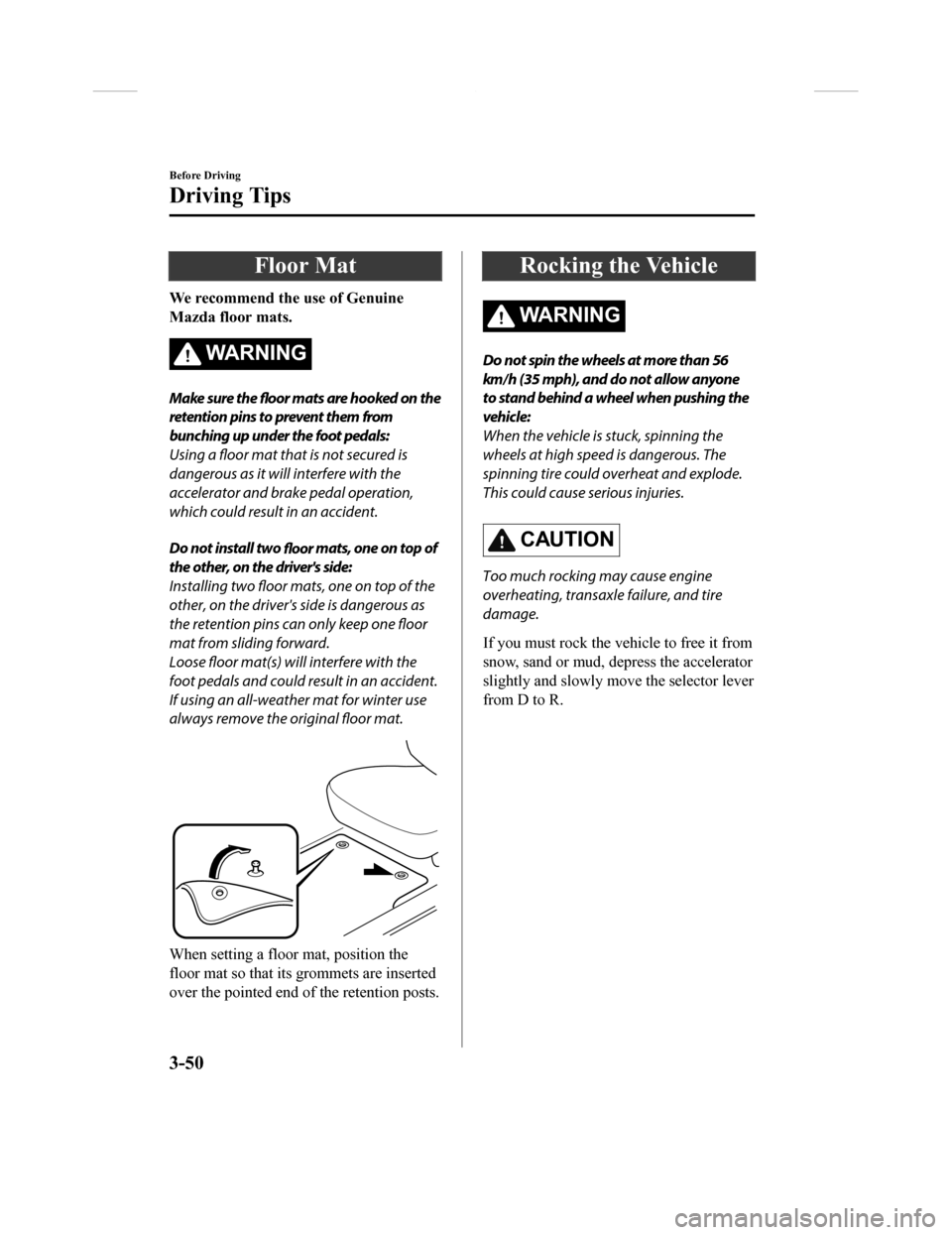
Floor Mat
We recommend the use of Genuine
Mazda floor mats.
WA R N I N G
Make sure the floor mats are hooked on the
retention pins to prevent them from
bunching up under the foot pedals:
Using a floor mat that is not secured is
dangerous as it will interfere with the
accelerator and brake pedal operation,
which could result in an accident.
Do not install two floor mats, one on top of
the other, on the driver's side:
Installing two floor mats, one on top of the
other, on the driver's side is dangerous as
the retention pins can only keep one floor
mat from sliding forward.
Loose floor mat(s) will interfere with the
foot pedals and could result in an accident.
If using an all-weather mat for winter use
always remove the original floor mat.
When setting a floor mat, position the
floor mat so that its grommets are inserted
over the pointed end of the retention posts.
Rocking the Vehicle
WA R N I N G
Do not spin the wheels at more than 56
km/h (35 mph), and do not allow anyone
to stand behind a wheel when pushing the
vehicle:
When the vehicle is stuck, spinning the
wheels at high speed is dangerous. The
spinning tire could overheat and explode.
This could cause serious injuries.
CAUTION
Too much rocking may cause engine
overheating, transaxle failure, and tire
damage.
If you must rock the vehicle to free it from
snow, sand or mud, depress the accelerator
slightly and slowly move the selector lever
from D to R.
Before Driving
Driving Tips
3-50
CX-9_8GC3-EA-17G_Edition1 2017-5-29 10:13:38
Page 141 of 640
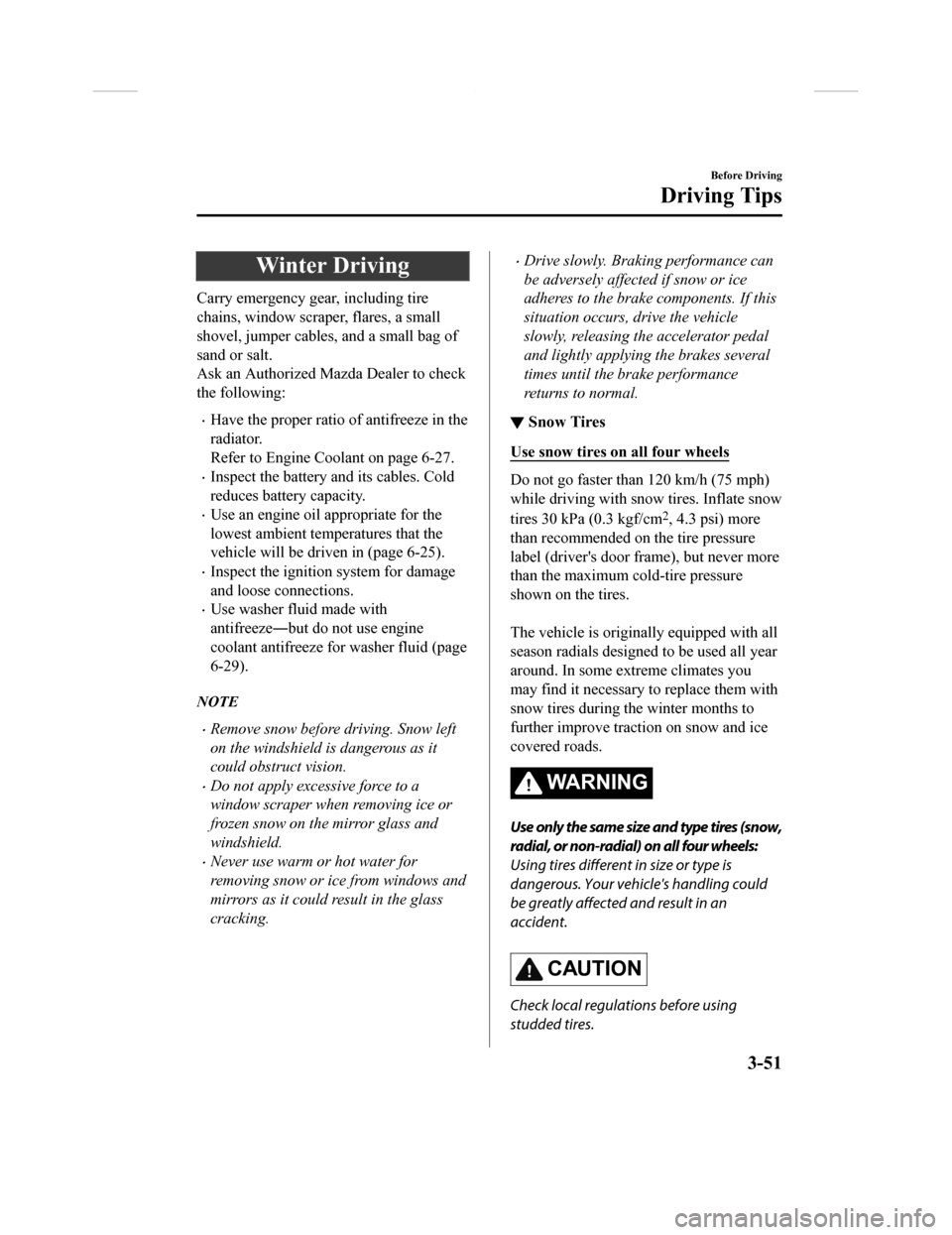
Winter Driving
Carry emergency gear, including tire
chains, window scraper, flares, a small
shovel, jumper cables, and a small bag of
sand or salt.
Ask an Authorized Maz da Dealer to check
the following:
•Have the proper ratio of antifreeze in the
radiator.
Refer to Engine Coolant on page 6-27.
•Inspect the ba ttery and its cables. Cold
reduces battery capacity.
•Use an engine oil appropriate for the
lowest ambient temperatures that the
vehicle will be driven in (page 6-25).
•Inspect the ignition system for damage
and loose connections.
•Use washer fluid made with
antifreeze―but do not use engine
coolant antifreeze for washer fluid (page
6-29).
NOTE
•Remove snow before driving. Snow left
on the windshield is dangerous as it
could obstruct vision.
•Do not apply excessive force to a
window scraper when removing ice or
frozen snow on the mirror glass and
windshield.
•Never use warm or hot water for
removing snow or ice from windows and
mirrors as it could result in the glass
cracking.
•Drive slowly. Braking performance can
be adversely affected if snow or ice
adheres to the brake components. If this
situation occurs, drive the vehicle
slowly, releasing the accelerator pedal
and lightly applying the brakes several
times until the brake performance
returns to normal.
▼ Snow Tires
Use snow tires on all four wheels
Do not go faster than 120 km/h (75 mph)
while driving with snow tires. Inflate snow
tires 30 kPa (0.3 kgf/cm
2, 4.3 psi) more
than recommended on the tire pressure
label (driver's door frame), but never more
than the maximum cold-tire pressure
shown on the tires.
The vehicle is origina lly equipped with all
season radials designed to be used all year
around. In some extreme climates you
may find it necessary to replace them with
snow tires during the winter months to
further improve traction on snow and ice
covered roads.
WA R N I N G
Use only the same size and type tires (snow,
radial, or non-radial) on all four wheels:
Using tires different in size or type is
dangerous. Your vehicle's handling could
be greatly affected and result in an
accident.
CAUTION
Check local regulations before using
studded tires.
Before Driving
Driving Tips
3-51
CX-9_8GC3-EA-17G_Edition1 2017-5-29 10:13:38
Page 143 of 640

Driving In Flooded Area
WA R N I N G
Dry off brakes that have become wet by
driving slowly, releasing the accelerator
pedal and lightly applying the brakes
several times until the brake performance
returns to normal:
Driving with wet brakes is dangerous.
Increased stopping distance or the vehicle
pulling to one side when braking could
result in a serious accident. Light braking
will indicate whether the brakes have been
affected.
CAUTION
Do not drive the vehicle on flooded roads
as it could cause short circuiting of
electrical/electronic parts, or engine
damage or stalling from water absorption.
If the vehicle has been immersed in water,
consult an Authorized Mazda Dealer.
Overloading
WA R N I N G
Be careful not to overload your vehicle:
The gross axle weight rating (GAWR) and
the gross vehicle weight rating (GVWR) of
the vehicle are on the Motor Vehicle Safety
Standard Label on the driver's door frame.
Exceeding these ratings can cause an
accident or vehicle damage. You can
estimate the weight of the load by
weighing the items (or people) before
putting them in the vehicle.
Before Driving
Driving Tips
3-53
CX-9_8GC3-EA-17G_Edition1 2017-5-29 10:13:38
Page 145 of 640

Turbocharger Information
CAUTION
After driving at freeway speeds or up a long h ill, idle the engine at least 30 seconds before
stopping it. Otherwise, the turbocharger could be damaged.
Racing or over-revving the engine, particularly after it's just been started, can damage the
turbocharger.
To protect the engine from damage, the engine is designed so that it cannot be raced just
after starting it in extremely cold weather.
The turbocharger greatly enhances engine power. Its advanced design provides improved
operation and requires minimum maintenance.
To get the most from it, observe the following.
1. Change engine oil and filter according to Scheduled Maintenan ce (page 6-4).
2. Use only recommended engine oil (page 6-25). Extra additives are NOT recommended.
Before Driving
Driving Tips
3-55
CX-9_8GC3-EA-17G_Edition1 2017-5-29 10:13:38
Page 146 of 640
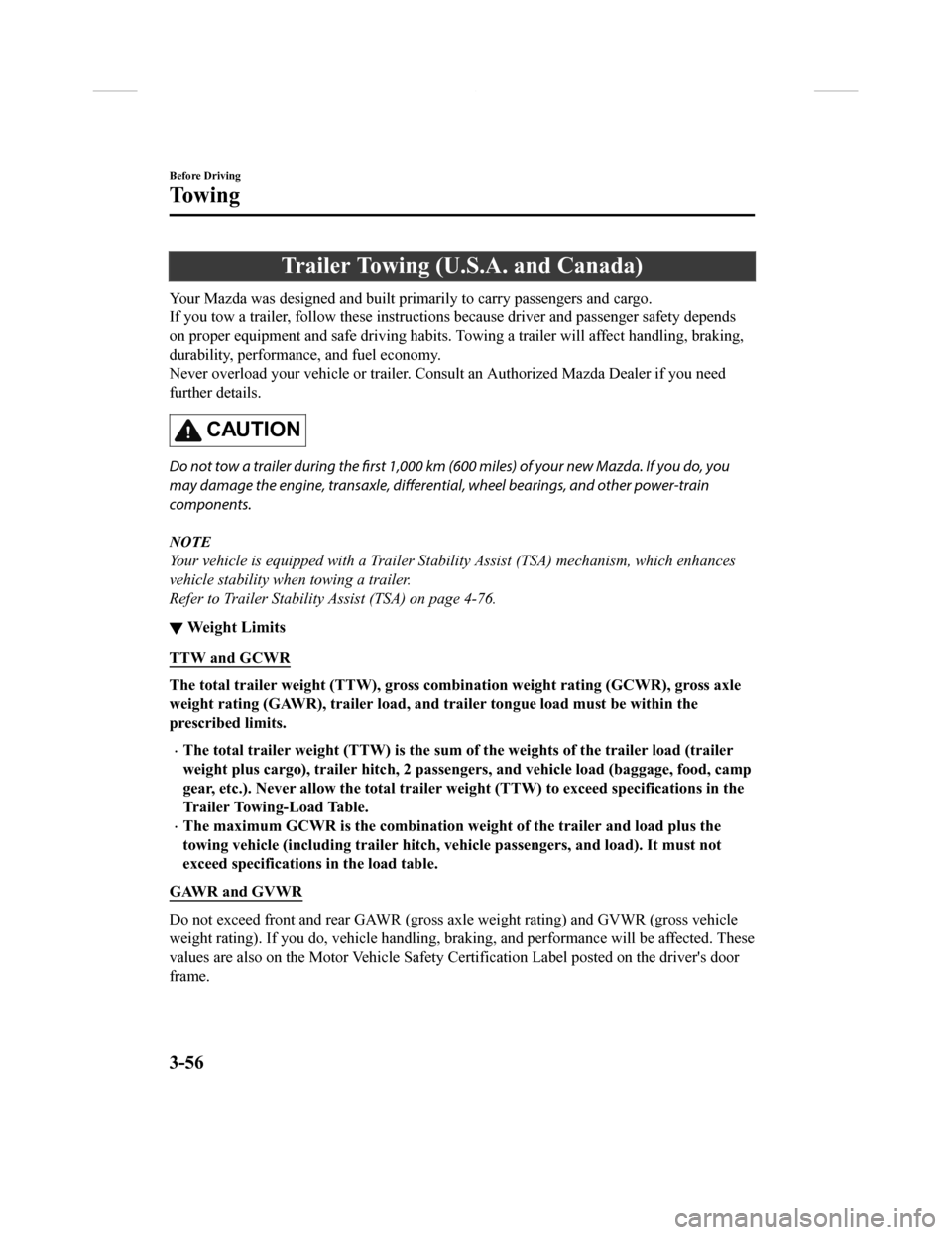
Trailer Towing (U.S.A. and Canada)
Your Mazda was designed and built primarily to carry passengers and cargo.
If you tow a trailer, follow these instructions because driver and passenger safety depends
on proper equipment and safe driving habits. Towing a trailer w ill affect handling, braking,
durability, performance , and fuel economy.
Never overload your vehicle or trailer. Consult an Authorized M azda Dealer if you need
further details.
CAUTION
Do not tow a trailer during the first 1,000 km (6 00 miles) of your new Mazda. If you do, you
may damage the engine, transaxle, differenti al, wheel bearings, and other power-train
components.
NOTE
Your vehicle is equipped with a Trailer St ability Assist (TSA) mechanism, which enhances
vehicle stability when towing a trailer.
Refer to Trailer Stability Assist (TSA) on page 4-76.
▼ Weight Limits
TTW and GCWR
The total trailer weight (TTW),
gross combination weight rating (GCWR), gross axle
weight rating (GAWR), trailer l oad, and trailer tongue load mus t be within the
prescribed limits.
•The total trailer weight (TTW) i s the sum of the weights of the trailer load (trailer
weight plus cargo), trailer hitc h, 2 passengers, and vehicle load (baggage, food, camp
gear, etc.). Never allow the total trailer weight (TTW) to exceed specifications in the
Trailer Towing-Load Table.
•The maximum GCWR is the combinat ion weight of the trailer and load plus the
towing vehicle (includ ing trailer hitch, vehicle passengers, and load). It must not
exceed specifications in the load table.
GAWR and GVWR
Do not exceed front and rear GAWR (gross axle weight rating) an d GVWR (gross vehicle
weight rating). If you do, vehicle handling, braking, and perfo rmance will be affected. These
values are also on the Motor Vehi cle Safety Certification Label posted on the driver's door
frame.
Before Driving
To w i n g
3-56
CX-9_8GC3-EA-17G_Edition1 2017-5-29 10:13:38
Page 147 of 640

High-altitude operation
CAUTION
Be aware of the towing load weight differences when towing at high altitudes. For altitudes
exceeding 1,000 meter (3,280 ft 10 in), always reduce the towing load by 10 % for every 1,000
meter (3,280 ft 10 in) increase in altitude from the load indicated under the maximum GCWR
heading in the trailer towing-load table. If the determined maximum total towing load
weight is exceeded, the engine and ot her power-train parts may be damaged.
TRAILER TOWING-LOAD TABLE
Because vehicle weights vary, adjustments must be made to meet the requirements in this
table.
Item Model
2WD AWD
MAX. FRON-
TA L A R E A
2.97 m2 (32 ft2)
MAX. TTW
1,587.5 kg (3,500 lb)
MAX. GCWR
3,629 kg (8,000.4 lb) 3,782 kg (8,337.7 lb)
MAX. GAWR
Front 1,217 kg (2,683 lb) 1,241 kg (2,736 lb)
Rear 1,386 kg (3,056 lb) 1,433 kg (3,159 lb)
MAX. GVWR
2,568 kg (5,661 lb) 2,638 kg (5,816 lb)
TRAIL-
ER-TONGUE
LOAD Tongue load
Tongue load/Trailer load × 100 = 10 % to 15 %
Trailer load
DISTRIBU-
TION OF
TRAILER
LOADFront 60 %
Rear 40 %
Before Driving
To w i n g
3-57
CX-9_8GC3-EA-17G_Edition1 2017-5-29 10:13:38
Page 149 of 640
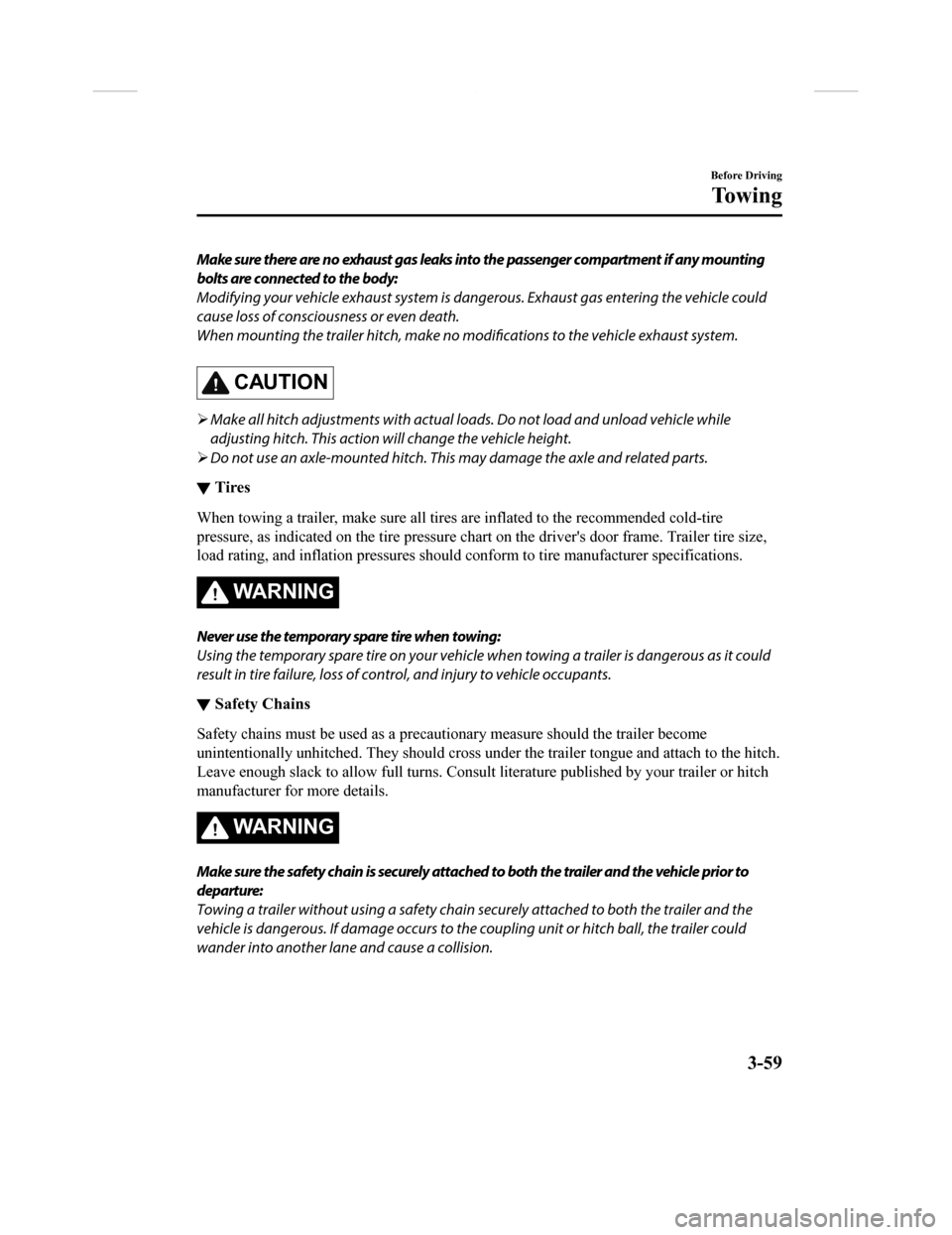
Make sure there are no exhaust gas leaks into the passenger compartment if any mounting
bolts are connected to the body:
Modifying your vehicle exhaust system is dangerous. Exhaust gas entering the vehicle could
cause loss of consciousness or even death.
When mounting the trailer hitch, make no modifications to the vehicle exhaust system.
CAUTION
Make all hitch adjustments with actual load s. Do not load and unload vehicle while
adjusting hitch. This action w ill change the vehicle height.
Do not use an axle-mounted hitch. This may damage the axle and related parts.
▼Tires
When towing a trailer, make sure all tires are inflated to the
recommended cold-tire
pressure, as indicated on the tire pressure chart on the driver 's door frame. Trailer tire size,
load rating, and inflation pressu res should conform to tire manufacturer specifications.
WA R N I N G
Never use the temporary spare tire when towing:
Using the temporary spare tire on your vehicle wh en towing a trailer is dangerous as it could
result in tire failure, loss of control, and injury to vehicle occupants.
▼ Safety Chains
Safety chains must be used as a
precautionary measure should th e trailer become
unintentionally unhitched. They should cross under the trailer tongue and attach to the hitch.
Leave enough slack to allow ful l turns. Consult literature published by your trailer or hitch
manufacturer for more details.
WA R N I N G
Make sure the safety chain is securely attached to both the trailer and the vehicle prior to
departure:
Towing a trailer without using a safety chain securely attached to both the trailer and the
vehicle is dangerous. If damage occurs to the coupling unit or hitch ball, the trailer could
wander into another lane and cause a collision.
Before Driving
To w i n g
3-59
CX-9_8GC3-EA-17G_Edition1 2017-5-29 10:13:38
Page 151 of 640

Driving
•Your Mazda will handle differently with a trailer in tow, so practice turning, backing, and
stopping in a traffic-free area.
•Take time to get accustomed to the extra weight and length.
•Allow more room between your vehicle and the one in front becau se braking distance
increases with a trailer. For eac h 16 km/h (10 mph) of speed, a llow at least one vehicle
and trailer length between your Mazda and the vehicle ahead.
•Avoid jerky starts or sudden acceleration.
•Avoid sudden braking. It may cau se loss of control and result in jackknifing, especially so
on wet or slippery roads.
•Shift the selector lever to the D position when towing a traile r in hilly terrain or when
heavily loaded.
The D position will allow opera ting the vehicle without frequen t shifting.
Lane changes and turning
Avoid quick lane changes, sudden turns, and tight turns. Slow d own before turning to avoid
the need of sudden braking.
A turning trailer will make a tigh ter arc than the tow vehicle. Compensate with turns that are
larger than normal.
Passing
Plan well ahead to pass other vehicles, and provide plenty of r oom before changing lanes.
Crosswinds from passing vehicles, especially larger ones, and t he effects of rough roads will
affect handling.
If swaying occurs, fir mly grip the steering wheel and reduce speed immediately, but
gradually.
Steer straight ahead. If no extreme correction of steering or b raking is made, the
combination of less speed and firm steering will result in stab ility.
Backing up
Backing a vehicle with a trailer requires practice and patience . Back slowly, and have a
helper outside at the rear of th e trailer to reduce the risk of an accident.
To turn the trailer, place your hand at the bottom of the steering wheel and turn it in the
direction you want the trailer to go. Make only slight movements to prevent sharp or
prolonged turning.
Ascending a hill
Shift into a lower gear to reduce the possibility of overloadin g or overheating the engine, or
both.
Before Driving
To w i n g
3-61
CX-9_8GC3-EA-17G_Edition1 2017-5-29 10:13:38